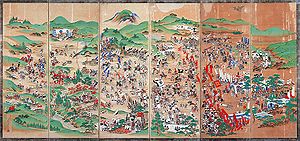Sekigahara
| Battle of Sekigahara | |||||||||
|---|---|---|---|---|---|---|---|---|---|
| Part of the Sengoku period | |||||||||
 Edo period screen depicting the battle. |
|||||||||
|
|||||||||
| Belligerents | |||||||||
| Western Army: Forces loyal to Toyotomi Hideyori, many clans from Western Japan | Eastern Army: Forces of Tokugawa Ieyasu, clans of Eastern Japan | ||||||||
| Commanders and leaders | |||||||||
|
Ishida Mitsunari Mōri Terumoto |
Tokugawa Ieyasu | ||||||||
| Strength | |||||||||
| 120,000 initially, 81,890 by the time of battle |
75,000 initially, 88,888 by the time of battle |
||||||||
| Casualties and losses | |||||||||
| 5,000–32,000 dead Ōtani Yoshitsugu † Shimazu Toyohisa † Toda Shigemasa † Shima Sakon † Natsuka Masaie † Toda Katsushige † Gamo Yorisato † ~23,000 defected |
Unknown; but not excessive Ii Naomasa (wounds) Matsudaira Tadayoshi (wounds) |
||||||||
The Battle of Sekigahara (Shinjitai: 関ヶ原の戦い; Kyūjitai: 關ヶ原の戰い Sekigahara no Tatakai?) was a decisive battle on October 21, 1600 (Keichō 5, 15th day of the 9th month) that preceded the establishment of the Tokugawa shogunate.
Tokugawa Ieyasu took three more years to consolidate his position of power over the Toyotomi clan and the daimyōs, but Sekigahara is widely considered to be the unofficial beginning of the Tokugawa bakufu, the last shogunate to control Japan. Japan had a long period of peace after the battle.
Oda Nobunaga had slowly consolidated control over much of Japan and was in control of the shogun, Ashikaga Yoshiaki. Ashikaga tried to escape this predicament in 1573 by attacking Oda, but failed and was exiled, thus ending his shogunate. Nobunaga ruled unopposed until he was betrayed by his own retainer Akechi Mitsuhide in 1582. While under attack in Kyoto, Nobunaga committed suicide by seppuku. Toyotomi Hideyoshi quickly avenged his master Nobunaga and consolidated control over Japan. Hideyoshi had risen from humble roots to become the ruler of Japan. His father was an ashigaru (foot-soldier). The death of Hideyoshi created a power vacuum in Japan, which ultimately was resolved by the outcome at Sekigahara.
Even though Toyotomi Hideyoshi unified Japan and consolidated his power following the Siege of Odawara in 1590, his failures in his invasions of Korea significantly weakened the Toyotomi clan's power as well as the support of the loyalists and bureaucrats that continued to serve and support the Toyotomi clan after Hideyoshi's death during the second invasion. Hideyoshi's and his brother Hidenaga's presence kept the two main factions of the time, which rallied behind Ishida Mitsunari and Tokugawa Ieyasu respectively, from anything more than quarreling, but when both of them died, the conflicts were exacerbated and developed into open hostilities. With no appointed shogun over the armies, this left a power vacuum in the Japanese government.
...
Wikipedia
